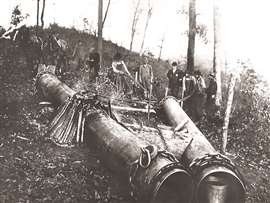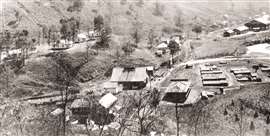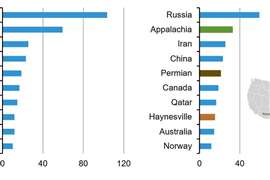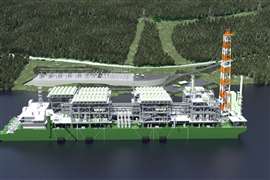Read this article in Français Deutsch Italiano Português Español
Cornerstones: Evolution of Pipelines and Compressor Stations - 3
September 20, 2025
The Cornerstones of Compression series has highlighted many significant products over more than 160 years of continuous progress. This is the third of six Cornerstones of Compression corollary articles that provide a look the evolution of natural gas pipelines and compressor stations.
 Men and horses towing pipe up a steep slope.
Men and horses towing pipe up a steep slope.
As explained in last month’s edition, thin-walled, seamless steel pipe was developed in the late 1890s. Oxyacetylene welding of steel pipe was perfected by 1910 and used commonly for pipelines by the 1920s. Electrically welded steel pipe was first used for gas pipelines in the 1920s. In 1936, the Hope Gas Company of West Virginia constructed the first all-welded high-pressure natural gas pipeline. A 12 in. (305 mm), 95 mi. (153 km) line connecting its Cornwell and Hastings stations, it proved unnecessary the previous practice of inserting couplings as expansion joints on long lines, and this hastened the development of a nationwide natural gas pipeline network. Electrically welded steel pipelines became common practice by 1940, hastening the development of the United States’ extensive gas transmission grid.
In the early 1940s, because of the greatly increased demand for natural gas created by war industries, the Hope Natural Gas Company proceeded to obtain right-of-way for a proposed long line to the Southwest, the first to make a portion of the vast gas reserves of that area available to Eastern markets. However, in 1943, in an unexpected decision, the U.S. Federal Power Commission permission to lay the line was awarded to another company, the upstart Tennessee Gas and Transmission Company.
Early Natural Gas Pipeline Compressor Stations
Development of early compressor stations was very challenging, as most of them were in remote, undeveloped areas with unfriendly terrain. The first compressor stations were crude affairs compared to present-day standards, but they were the start of one of the most important phases of the natural gas industry. A story related by the Hope Natural Gas Company upon their 75th anniversary in 1974 provides some interesting insight into early compressor stations.
It was quite a chore to construct a compressor station in those early days, particularly in territory where the narrow dirt roads that laced the rugged countryside were the only means of access to the sites. As shown in last month’s edition, the heavy equipment, weighing many tons, was loaded onto wagons at the nearest railroad siding. Then, in a slow, intermittent procession, it was hauled up the hills and through the valleys by long lines of straining horses and mules. It was rough going even in dry weather, and when there was mud, it was awful. The erection of a station wasn’t easy, either. Fig. 1 shows men and horses at work towing pipe up a steep slope. Nevertheless, those pioneer stations did get built and helped considerably to bring about the development of natural gas into one of the nation’s largest industries.
In the early part of the 20th century, the 12-hour work day and seven-day work week were standard operating procedure, and manpower and horsepower really meant what the words imply. As one man put it in relating what a hard time he’d had in getting a day off to get married, “It wasn’t the bride who set the date in those days – the boss did.”
The first natural gas compressor station was built in 1890 in the Murrysville field, a few miles east of Pittsburgh, Pennsylvania. For quite a few years, compressors were directly connected to horizontal steam and (later) gas engines. These units were big and heavy in proportion to the power developed, but they were very sturdy and dependable. Many remained in service for more than 40 years, some much longer than that.
Construction of the Hastings Station, which later became the hub of Hope Natural Gas Company’s transmission system, began in 1902. The station was built on a five-acre (2.5 ha) site with a yearly rental of $150. Four years later, in 1906, Hope bought the property, which was located near the town of Pine Grove, West Virginia, along with an additional 145 acres (58.7 ha). The installation of two original 4500 hp (3356 kW) Snow horizontal gas engine-compressors, at the time the largest ever used to pump gas, were completed at the Hastings station using cut stone foundations in the fall of 1903. In 1912, these twin tandem engines were cut in half to make single tandem engines, so that only half the power would be lost in case of engine trouble. These rugged engines remained in service until 1945.
Wedged between steep Wetzel County hills, the Hastings installation was 20 mi. (32 km) away from the nearest large town. Because of this, a plant community providing gas, water, electric and sewage services had to be developed. At one time there were more than 60 company-owned dwellings and a company-operated general store. There was also a church, a post office, a small hotel, a community hall and a big athletic field as the station grew in size and encompassed more than a thousand acres (405 ha). Although most stations were not as large as Hastings, the development of on-site capabilities and company-owned living quarters for the station operating personnel were normal practice in these remote locations.
 Early Hope Natural Gas Jones Compressor Station complex in Gilmer County, West Virginia with the compressor house at upper right, boarding house in foreground and company homes on the bank at upper left.
Early Hope Natural Gas Jones Compressor Station complex in Gilmer County, West Virginia with the compressor house at upper right, boarding house in foreground and company homes on the bank at upper left.
Fig. 2 shows Hope Natural Gas Company’s Jones Station in Gilmer County, West Virginia, another of the company’s larger installations in the early years. Visible at left on the bank are some company homes. In the foreground is a boarding house and just above it is the company barn. At upper right, above the pipe yard, the large building is the compressor house that was the heart of the station.
Not all of the early compressor stations had mammoth horizontals as large as the Snow units installed at the Hastings station. Just as today, the early grid consisted of smaller boosting stations feeding larger pipelines with larger compressors. The equipment in early compressor stations covered a wide power range provided by manufacturers such as Cooper, Bessemer, Snow, Miller, Laidlaw-Dunn-Gordon and others. A c.1923 journal, neatly hand-printed in blue ink, documented the equipment and brief histories of most of the pipeline compressor stations of the Ohio Fuel Gas Company, one of the earliest pipeline companies. The records provide insight into the varying sizes of the stations and engine-compressors that were deployed in the early part of the 20th century. The next three editions will provide a better glimpse of this early pipeline system.
MAGAZINE
NEWSLETTER

CONNECT WITH THE TEAM








